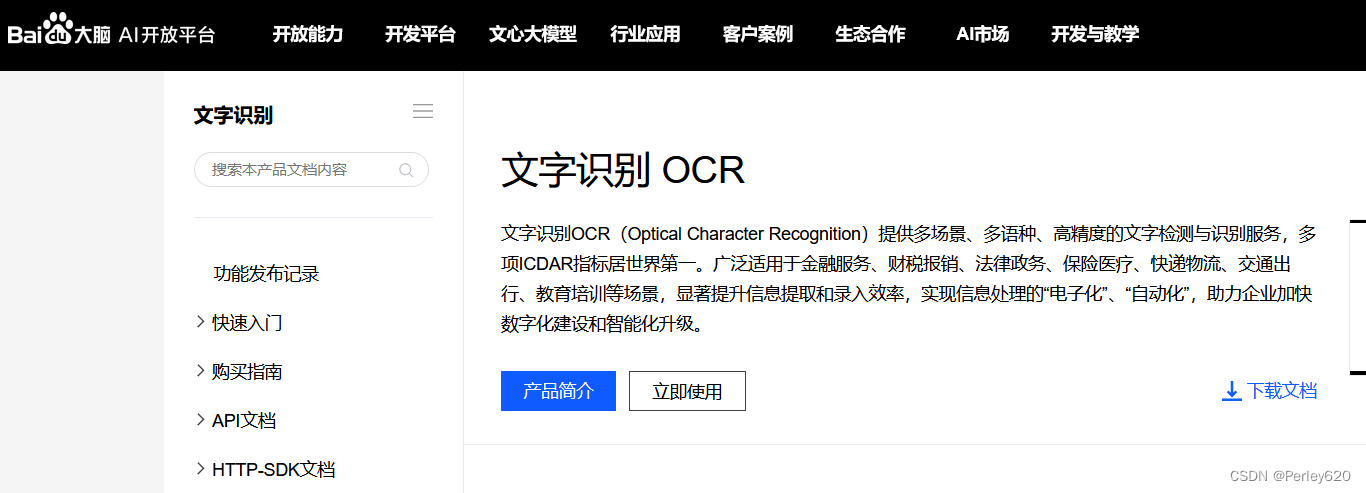
前言
前言:本系列博客尝试结合官网案例,阐述百度 AI 开放平台里的组件使用方式,核心是如何在spring项目中快速上手应用。
本文介绍如何在Springboot中使用百度AI的文字识别OCR

其他相关的使用百度AI的文章列表如下:
如何在Springboot中使用语音文件识别 & ffmpeg的安装和使用

文章目录
引出
1.从官网demo到idea中使用;
2.如何阅读官网的说明文档,小经验分享;

小经验:如何使用官方文档
https://ai.baidu.com/ai-doc/index/OCR
https://ai.baidu.com/ai-doc/OCR/Ek3h7xypm
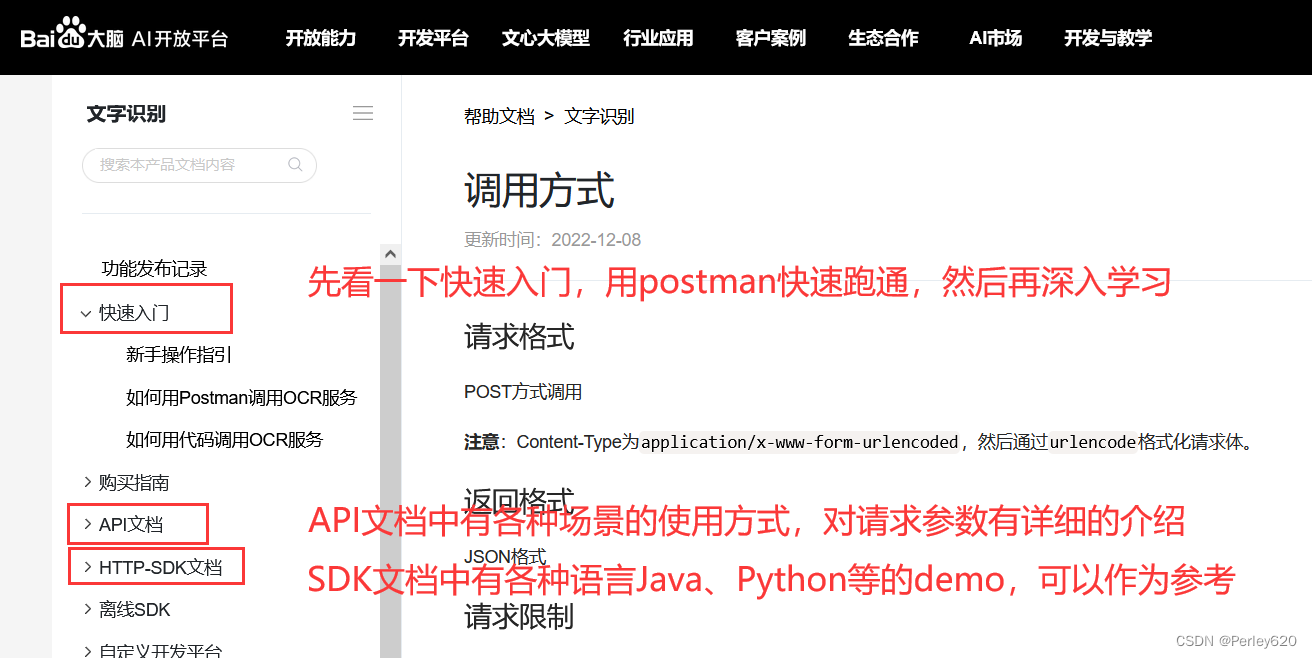
1.API文档的使用
万里长征第一步,Ctrl c + v,复制粘贴
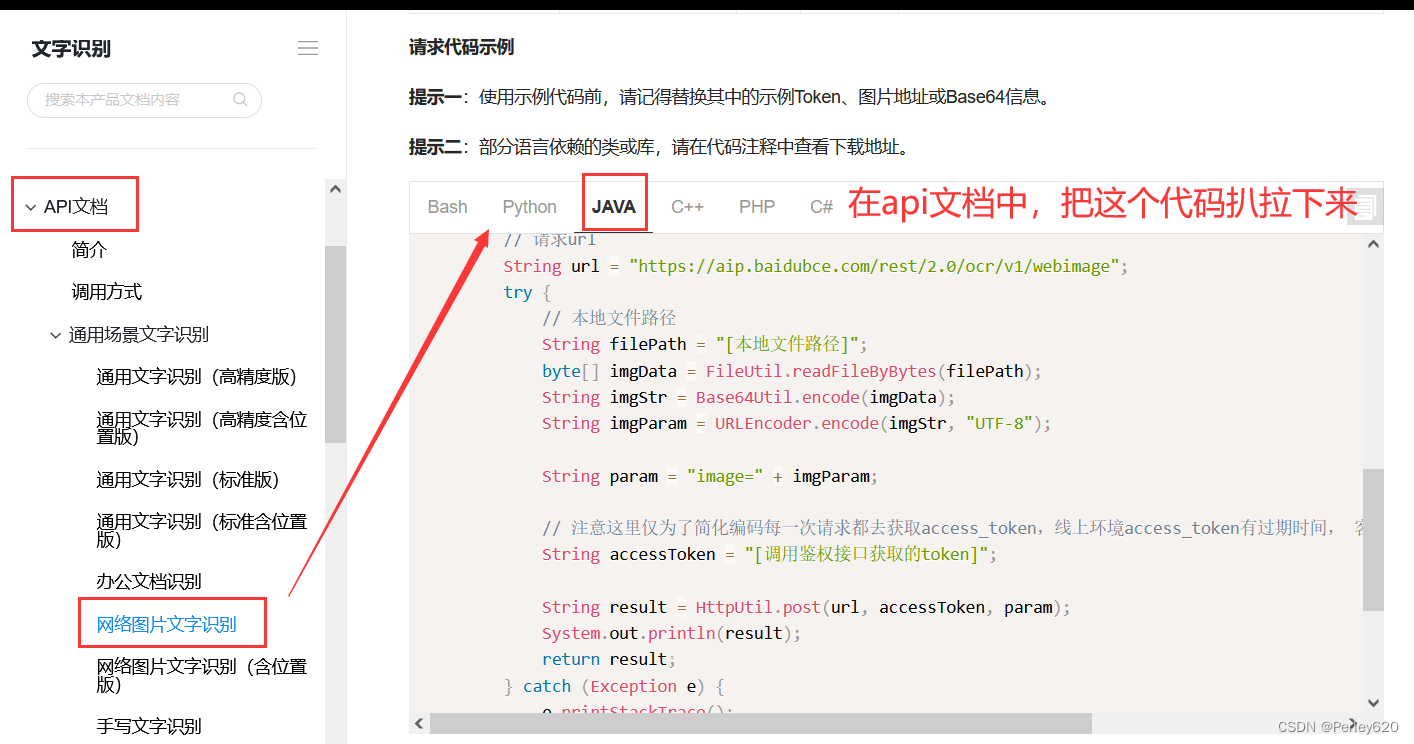
2.HTTP-SDK文档的使用
网络请求SDK案例
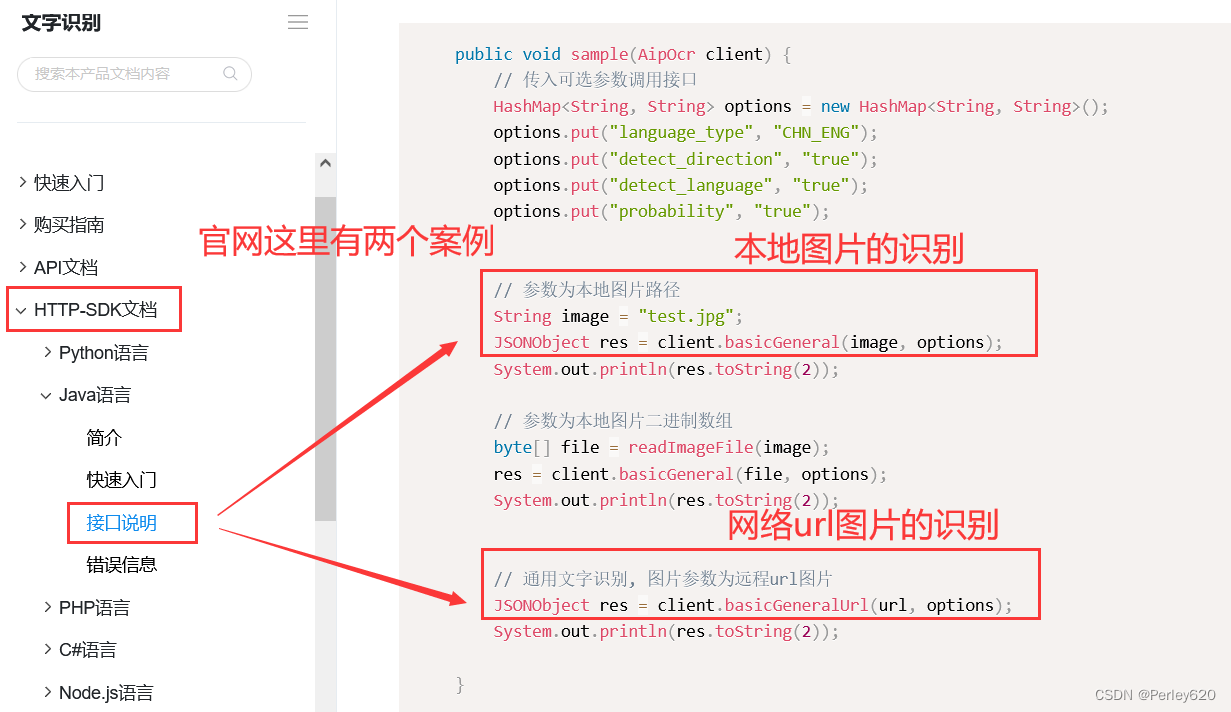
基于官网案例demo的实现
从官网的案例到spring项目整合

1.使用AipOcr客户端
BaiduOcrPro实体类
package com.tianju.config.baidu;
import lombok.AllArgsConstructor;
import lombok.Data;
import lombok.NoArgsConstructor;
import org.springframework.boot.context.properties.ConfigurationProperties;
import org.springframework.context.annotation.PropertySource;
import org.springframework.stereotype.Component;
/**
* OCR相关的配置
*/
@Component
@ConfigurationProperties(prefix = "baidu.ocr")
@PropertySource("classpath:config/baiduAip.properties")
@Data
@NoArgsConstructor
@AllArgsConstructor
public class BaiduOcrPro {
private String appId;
private String apiKey;
private String secretKey;
}
初始化AipOcr,放到spring容器中
package com.tianju.config.baidu;
import com.baidu.aip.ocr.AipOcr;
import com.baidu.aip.speech.AipSpeech;
import org.springframework.beans.factory.annotation.Autowired;
import org.springframework.context.annotation.Bean;
import org.springframework.context.annotation.Configuration;
/**
* 百度相关的配置文件
*/
@Configuration
public class BaiduConfig {
@Autowired
private BaiduOcrPro baiduOcrPro;
/**
* 图像相关的 AipOcr
* @return AipOcr 放容器中
*/
@Bean
public AipOcr aipOcr(){
AipOcr aipOcr = new AipOcr(baiduOcrPro.getAppId(),
baiduOcrPro.getApiKey(),
baiduOcrPro.getSecretKey());
// 可选:设置网络连接参数
aipOcr.setConnectionTimeoutInMillis(2000);
aipOcr.setSocketTimeoutInMillis(60000);
return aipOcr;
}
}
controller层进行调用
package com.tianju.config.controller;
import com.baidu.aip.ocr.AipOcr;
import com.tianju.config.resp.HttpResp;
import com.tianju.config.util.baidu.Base64Util;
import com.tianju.config.util.baidu.FileUtil;
import com.tianju.config.util.baidu.HttpUtil;
import org.json.JSONArray;
import org.json.JSONObject;
import org.springframework.beans.factory.annotation.Autowired;
import org.springframework.web.bind.annotation.GetMapping;
import org.springframework.web.bind.annotation.RequestMapping;
import org.springframework.web.bind.annotation.RestController;
import java.net.URLEncoder;
import java.util.HashMap;
@RestController
@RequestMapping("/api/baidu/ocr")
public class BaiduOCRController {
@Autowired
private AipOcr aipOcr;
// http://124.70.138.34:9000/hello/1.jpg
@GetMapping("/imgUrl")
public HttpResp ocrFromImgUrl(String imgUrl){
// 传入可选参数调用接口
HashMap<String, String> options = new HashMap<String, String>();
options.put("language_type", "CHN_ENG");
options.put("detect_direction", "true");
options.put("detect_language", "true");
options.put("probability", "true");
/**
* 网络图像
*/
JSONObject res = aipOcr.basicGeneralUrl(
imgUrl,
options
);
/**
* {"words_result":
* [{"probability":{"average":0.9994496107,"min":0.9990026355,"variance":1.469044975E-7},
* "words":"爱我中华"}],
* "log_id":1705920508293856573,"words_result_num":1,"language":3,"direction":0}
*/
JSONArray wordsResult = (org.json.JSONArray)res.get("words_result");
JSONObject o = (JSONObject) wordsResult.get(0);
Object words = o.get("words");
System.out.println(words);
System.out.println("######################");
System.out.println(res.toString(2));
return HttpResp.success(words);
}
}

2.使用官网的HttpUtil工具类
package com.tianju.config.controller;
import com.baidu.aip.ocr.AipOcr;
import com.tianju.config.resp.HttpResp;
import com.tianju.config.util.baidu.Base64Util;
import com.tianju.config.util.baidu.FileUtil;
import com.tianju.config.util.baidu.HttpUtil;
import org.json.JSONArray;
import org.json.JSONObject;
import org.springframework.beans.factory.annotation.Autowired;
import org.springframework.web.bind.annotation.GetMapping;
import org.springframework.web.bind.annotation.RequestMapping;
import org.springframework.web.bind.annotation.RestController;
import java.net.URLEncoder;
import java.util.HashMap;
@RestController
@RequestMapping("/api/baidu/ocr")
public class BaiduOCRController {
/**
* 以下为官网的案例,token的方式
* https://ai.baidu.com/ai-doc/OCR/zk3h7xz52
*/
public static String generalBasic() {
// 请求url
String url = "https://aip.baidubce.com/rest/2.0/ocr/v1/general_basic";
try {
// 本地文件路径
String filePath = "D:\\Myprogram\\springboot-workspace\\spring-project\\baidu-api\\src\\main\\resources\\static\\ocr_test.jpg";
byte[] imgData = FileUtil.readFileByBytes(filePath);
String imgStr = Base64Util.encode(imgData);
String imgParam = URLEncoder.encode(imgStr, "UTF-8");
String param = "image=" + imgParam;
System.out.println(param);
// 注意这里仅为了简化编码每一次请求都去获取access_token,线上环境access_token有过期时间, 客户端可自行缓存,过期后重新获取。
String accessToken = "24.2f4d3e23a805ba89627472c38addcdcd.2592000.1698147302.282335-38781099";
String result = HttpUtil.post(url, accessToken, param);
System.out.println(result);
return result;
} catch (Exception e) {
e.printStackTrace();
}
return null;
}
public static void main(String[] args) {
generalBasic();
}
}
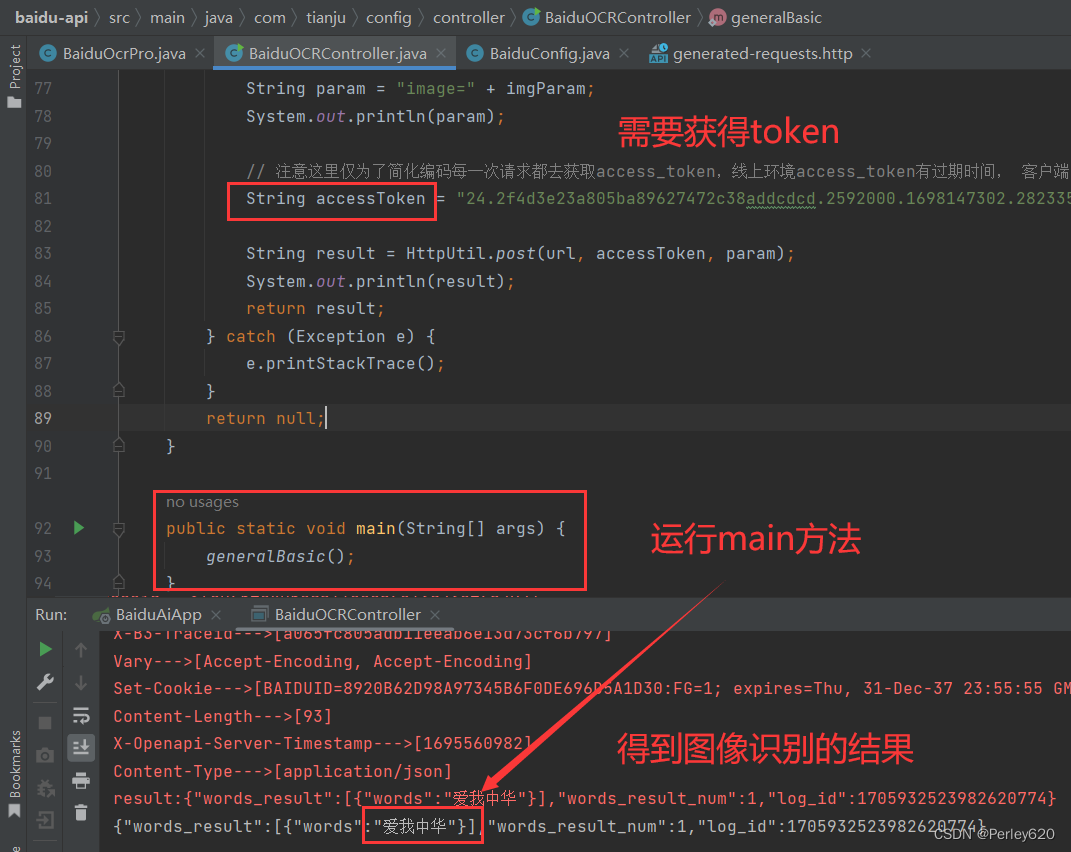
附录:官网的工具类
1.Base64Util图片编码工具
package com.tianju.config.util.baidu;
/**
* Base64 工具类
*/
public class Base64Util {
private static final char last2byte = (char) Integer.parseInt("00000011", 2);
private static final char last4byte = (char) Integer.parseInt("00001111", 2);
private static final char last6byte = (char) Integer.parseInt("00111111", 2);
private static final char lead6byte = (char) Integer.parseInt("11111100", 2);
private static final char lead4byte = (char) Integer.parseInt("11110000", 2);
private static final char lead2byte = (char) Integer.parseInt("11000000", 2);
private static final char[] encodeTable = new char[]{
'A', 'B', 'C', 'D', 'E', 'F', 'G', 'H', 'I', 'J', 'K', 'L', 'M', 'N', 'O', 'P', 'Q', 'R', 'S', 'T', 'U', 'V', 'W', 'X', 'Y', 'Z', 'a', 'b', 'c', 'd', 'e', 'f', 'g', 'h', 'i', 'j', 'k', 'l', 'm', 'n', 'o', 'p', 'q', 'r', 's', 't', 'u', 'v', 'w', 'x', 'y', 'z', '0', '1', '2', '3', '4', '5', '6', '7', '8', '9', '+', '/'};
public Base64Util() {
}
public static String encode(byte[] from) {
StringBuilder to = new StringBuilder((int) ((double) from.length * 1.34D) + 3);
int num = 0;
char currentByte = 0;
int i;
for (i = 0; i < from.length; ++i) {
for (num %= 8; num < 8; num += 6) {
switch (num) {
case 0:
currentByte = (char) (from[i] & lead6byte);
currentByte = (char) (currentByte >>> 2);
case 1:
case 3:
case 5:
default:
break;
case 2:
currentByte = (char) (from[i] & last6byte);
break;
case 4:
currentByte = (char) (from[i] & last4byte);
currentByte = (char) (currentByte << 2);
if (i + 1 < from.length) {
currentByte = (char) (currentByte | (from[i + 1] & lead2byte) >>> 6);
}
break;
case 6:
currentByte = (char) (from[i] & last2byte);
currentByte = (char) (currentByte << 4);
if (i + 1 < from.length) {
currentByte = (char) (currentByte | (from[i + 1] & lead4byte) >>> 4);
}
}
to.append(encodeTable[currentByte]);
}
}
if (to.length() % 4 != 0) {
for (i = 4 - to.length() % 4; i > 0; --i) {
to.append("=");
}
}
return to.toString();
}
}
2.FileUtil读取文件工具类
package com.tianju.config.util.baidu;
import java.io.*;
/**
* 文件读取工具类
*/
public class FileUtil {
/**
* 读取文件内容,作为字符串返回
*/
public static String readFileAsString(String filePath) throws IOException {
File file = new File(filePath);
if (!file.exists()) {
throw new FileNotFoundException(filePath);
}
if (file.length() > 1024 * 1024 * 1024) {
throw new IOException("File is too large");
}
StringBuilder sb = new StringBuilder((int) (file.length()));
// 创建字节输入流
FileInputStream fis = new FileInputStream(filePath);
// 创建一个长度为10240的Buffer
byte[] bbuf = new byte[10240];
// 用于保存实际读取的字节数
int hasRead = 0;
while ( (hasRead = fis.read(bbuf)) > 0 ) {
sb.append(new String(bbuf, 0, hasRead));
}
fis.close();
return sb.toString();
}
/**
* 根据文件路径读取byte[] 数组
*/
public static byte[] readFileByBytes(String filePath) throws IOException {
File file = new File(filePath);
if (!file.exists()) {
throw new FileNotFoundException(filePath);
} else {
ByteArrayOutputStream bos = new ByteArrayOutputStream((int) file.length());
BufferedInputStream in = null;
try {
in = new BufferedInputStream(new FileInputStream(file));
short bufSize = 1024;
byte[] buffer = new byte[bufSize];
int len1;
while (-1 != (len1 = in.read(buffer, 0, bufSize))) {
bos.write(buffer, 0, len1);
}
byte[] var7 = bos.toByteArray();
return var7;
} finally {
try {
if (in != null) {
in.close();
}
} catch (IOException var14) {
var14.printStackTrace();
}
bos.close();
}
}
}
}
3.基于Google的gson的Json工具类
/*
* Copyright (C) 2017 Baidu, Inc. All Rights Reserved.
*/
package com.tianju.config.util.baidu;
import com.google.gson.Gson;
import com.google.gson.GsonBuilder;
import com.google.gson.JsonParseException;
import java.lang.reflect.Type;
/**
* Json工具类.
*/
public class GsonUtils {
private static Gson gson = new GsonBuilder().create();
public static String toJson(Object value) {
return gson.toJson(value);
}
public static <T> T fromJson(String json, Class<T> classOfT) throws JsonParseException {
return gson.fromJson(json, classOfT);
}
public static <T> T fromJson(String json, Type typeOfT) throws JsonParseException {
return (T) gson.fromJson(json, typeOfT);
}
}
4.Http请求发起和获得响应工具类
package com.tianju.config.util.baidu;
import java.io.BufferedReader;
import java.io.DataOutputStream;
import java.io.InputStreamReader;
import java.net.HttpURLConnection;
import java.net.URL;
import java.util.List;
import java.util.Map;
/**
* http 工具类
*/
public class HttpUtil {
public static String post(String requestUrl, String accessToken, String params)
throws Exception {
String contentType = "application/x-www-form-urlencoded";
return HttpUtil.post(requestUrl, accessToken, contentType, params);
}
public static String post(String requestUrl, String accessToken, String contentType, String params)
throws Exception {
String encoding = "UTF-8";
if (requestUrl.contains("nlp")) {
encoding = "GBK";
}
return HttpUtil.post(requestUrl, accessToken, contentType, params, encoding);
}
public static String post(String requestUrl, String accessToken, String contentType, String params, String encoding)
throws Exception {
String url = requestUrl + "?access_token=" + accessToken;
return HttpUtil.postGeneralUrl(url, contentType, params, encoding);
}
public static String postGeneralUrl(String generalUrl, String contentType, String params, String encoding)
throws Exception {
URL url = new URL(generalUrl);
// 打开和URL之间的连接
HttpURLConnection connection = (HttpURLConnection) url.openConnection();
connection.setRequestMethod("POST");
// 设置通用的请求属性
connection.setRequestProperty("Content-Type", contentType);
connection.setRequestProperty("Connection", "Keep-Alive");
connection.setUseCaches(false);
connection.setDoOutput(true);
connection.setDoInput(true);
// 得到请求的输出流对象
DataOutputStream out = new DataOutputStream(connection.getOutputStream());
out.write(params.getBytes(encoding));
out.flush();
out.close();
// 建立实际的连接
connection.connect();
// 获取所有响应头字段
Map<String, List<String>> headers = connection.getHeaderFields();
// 遍历所有的响应头字段
for (String key : headers.keySet()) {
System.err.println(key + "--->" + headers.get(key));
}
// 定义 BufferedReader输入流来读取URL的响应
BufferedReader in = null;
in = new BufferedReader(
new InputStreamReader(connection.getInputStream(), encoding));
String result = "";
String getLine;
while ((getLine = in.readLine()) != null) {
result += getLine;
}
in.close();
System.err.println("result:" + result);
return result;
}
}
总结
1.从官网demo到idea中使用;
2.如何阅读官网的说明文档,小经验分享;